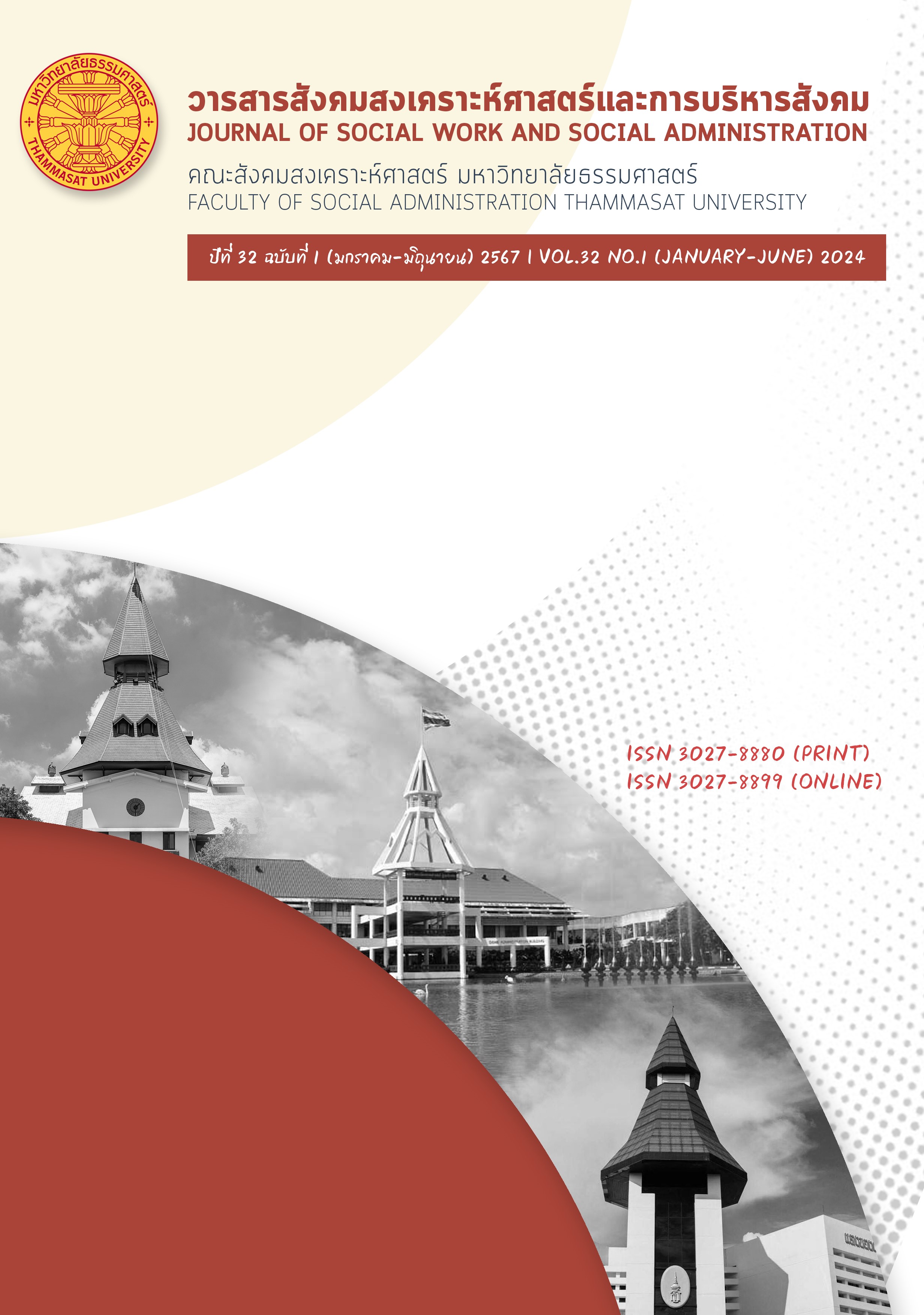ความหยุ่นตัวและการปรับตัวในการปฏิบัติงานสังคมสงเคราะห์ภายใต้สถานการณ์วิกฤติ
คำสำคัญ:
ความหยุ่นตัว, สังคมสงเคราะห์, สถานการณ์วิกฤติ, โควิด-19, การปรับตัวบทคัดย่อ
สถานการณ์วิกฤติ COVID-19 สะท้อนให้เห็นภาพการปรับตัวเพื่อ
ความอยู่รอดของมนุษย์ ทั้งระดับบุคคล กลุ่มองค์กร ชุมชน และสังคม สิ่งสำคัญ คือ ความหยุ่นตัวอันเกิดจากการรับมือกับสถานการณ์ที่เกิดขึ้นและการฟื้นคืนสภาพกลับเข้าสู่ภาวะปกติอีกครั้ง วัตถุประสงค์ของบทความนี้เพื่อศึกษาความหยุ่นตัวและการปรับตัวของการปฏิบัติงานสังคมสงเคราะห์ภายใต้สถานการณ์วิกฤติโรคระบาด COVID-19 เก็บข้อมูลจากการสัมภาษณ์เจาะลึกจากผู้ปฏิบัติงานสังคมสงเคราะห์ จำนวน 16 คน วิเคราะห์ข้อมูลโดยใช้วิธีการวิเคราะห์เนื้อหา ตีความและการวิเคราะห์สรุปอุปนัย พบว่า การปฏิบัติงานตามบทบาทหน้าที่ความรับผิดชอบของผู้ปฏิบัติงานสังคมสงเคราะห์ภายใต้ความท้าทายของวิกฤตการณ์การระบาดใหญ่เป็นการทำงานภายใต้ขอบเขตของมาตรการควบคุมโรคของภาครัฐ ภาวะความกดดัน ความเสี่ยงต่อการติดเชื้อ ความคาดหวังของผู้ใช้บริการ หน่วยงานและสังคมต่อวิชาชีพสังคมสงเคราะห์ที่ให้ความช่วยเหลือ ผลักดันให้ผู้ปฏิบัติงานต้องสร้างความหยุ่นตัว การปรับเปลี่ยนพฤติกรรม ความรู้สึกนึกคิด ความเชื่อ สภาพแวดล้อมให้เหมาะสมสอดคล้องกับสถานการณ์ที่เปลี่ยนแปลง ตลอดจนการแสวงหาวิธีการปฏิบัติงานใหม่ๆ การหาทางออกด้วยการพึ่งพาความทันสมัยของเทคโนโลยี การพึ่งพาเครือข่ายการทำงาน
การปรับเปลี่ยนกลยุทธ์การปฏิบัติงาน เพื่อจัดการแก้ไขปัญหาและแสวงหาการสนับสนุนทางสังคม แนวทางเพื่อสร้างความหยุ่นตัวในการตอบสนองต่อสถานการณ์วิกฤติในปัจจุบันและอนาคต ผู้ปฏิบัติงานควรฝึกควบคุมกาย จิต และสติของตนเองเพื่อรับมือกับสถานการณ์ต่างๆ การกำหนดแนวทางสร้างความสามารถในการหยุ่นตัวเป็นแผนระยะยาว การถอดบทเรียนสร้างองค์ความรู้จากประสบการณ์ที่ผ่านมา ส่งเสริมความเข้มแข็งให้ชุมชนและทุกภาคส่วนเพื่อเป็นฐานการให้ความช่วยเหลือ ภาครัฐควรตระหนักถึงการกำกับดูแลแบบมีส่วนร่วม การกระจายทรัพยากร การสร้างโปรแกรมการคุ้มครองทางสังคมที่ครอบคลุมประชาชนโดยเฉพาะกลุ่มคนเปราะบาง
เอกสารอ้างอิง
กระทรวงสาธารณสุข กลุ่มพัฒนาวิชาการโรคติดต่อ. (2564). สถานการณ์โรคติดเชื้อไวรัสโคโรนา 2019 (COVID-19) มาตรการสาธารณสุข และปัญหาอุปสรรคการป้องกันควบคุมโรคในผู้เดินทาง. สืบค้นจาก https://ddc.moph.go.th/uploads/files/2017420210820025238.pdf
บัญชา เกิดมณี, สุรชัย ธรรมทวีธิกุล, ญานพินิจ วชิรสุรงค์, บดินทร์ชาติ สุขบท และ สมบัติ ทีฆทรัพย์. (2563). แนวคิดและทิศทางการแก้ปัญหาโควิด-19. วารสารก้าวทันโลกวิทยาศาสตร์, 20(1), 1-12.
ศศิวัฒน์ ตันติบุญยานนท์. (2564). การจัดการเรียนรู้เพื่อเสริมสร้างสมรรถนะ “ล้มแล้วลุก” บนเทคโนโลยีคลาวด์ ตามฐานความคิดผู้นำ 4 แบบในช่วงวิกฤติ. วารสารครุศาสตร์ปริทรรศน์, 8(1), 361-374.
Alizadeh, H., & Sharifi, A. (2022). Social Resilience Promotion Factors during the COVID-19 Pandemic: Insights from Urmia, Iran. Urban Science, 6(14), 1-14.
American Psychological Association (APA). (2011). Resilience. Retrieve from https://www.apa.org/topics/resilience
Andia, T., & Sharifi, A (2021). Inequalities and Social Resilience in Times of COVID-19. Revista de Estudios Sociales, 78(10),
-13.
Bilal S. H. Badr Naga and Nijmeh M. H. Al-Atiyyat. (2014). Roy Adaptation Model. Middle East Journal of Nursing, 7(1), 58-61.
Caza, B. B., & Milton, L. P. (2012). Resilience at work: Building capacity in the face of adversity. In K. S. Cameron & G. M. Spreitzer (Eds.), Handbook of positive organizational scholarship (pp. 895-908). New York: Oxford University Press.
Cooper, C., Flint-Taylor, J., & Pearn, M. (2013). Building resilience for success: A resource for managers and organizations. Hampshire: Palgrave Macmillan.
Debele, E. T., & Sima, M. E. (2021). Social Resilience and Challenges of COVID-19. Technium Business and Management (TBM), 1(1), 19-29.
Kim, M., & Windsor, C. (2015). Resilience and work-life balance in first-line nurse manager. Asian nursing research, 9(1), 21-27.
Maclean, K., Ross, H., Cuthill, M., Witt, B., (2017). Converging disciplinary understandings of social aspects of resilience. Journal of Environmental Planning and Management, 60(3), 519-537. https://doi.org/10.1080/09640568.2016.1162706
Roy, C., & Andrews, H. (1999). The Roy adaptation model (2nd ed.). Stamford, CT: Appleton & Lange.
Schmidt-Sane, M., Hrynick, T., & Niederberger, E., (2021). Community resilience: Key concept and their applications to epidemic shock,’ Science in Humanitarian Action (SSHAP). Retrieve from https://www.socialscienceinaction.org /resources/community-resilience-key-concepts-and-their-applications-to-epidemic-shocks/
Warner, R., & April, K. (2012). Building personal resilience at work. Effective Executive, 15(4), 53-68.
Windle, G., Bennett, K. M., & Noyes, J. (2011). A methodological review of resilience measurement scales. Health and Quality of Life Outcomes, 9(8), 1-18.
ดาวน์โหลด
เผยแพร่แล้ว
รูปแบบการอ้างอิง
ฉบับ
ประเภทบทความ
สัญญาอนุญาต
ลิขสิทธิ์ (c) 2024 วารสารสังคมสงเคราะห์ศาสตร์และการบริหารสังคม

อนุญาตภายใต้เงื่อนไข Creative Commons Attribution-NonCommercial-NoDerivatives 4.0 International License.
ผลงานที่ตีพิมพ์ในวารสารสังคมสงเคราะห์ศาสตร์เป็นลิขสิทธิ์ของวารสารสังคมสงเคราะห์ศาสตร์ มหาวิทยาลัยธรรมศาสตร์ และวารสารสังคมสงเคราะห์ศาสตร์ มหาวิทยาลัยธรรมศาสตร์ ขอสงวนสิทธิในการเผยแพร่ผลงานที่ตีพิมพ์ในแบบรูปเล่มและทางสื่ออิเล็กทรอนิกส์อื่นใด
บทความหรือข้อความคิดเห็นใดๆ ที่ปรากฏในวารสารสังคมสงเคราะห์ศาสตร์เป็นความรับผิดชอบของผู้เขียนโดยเฉพาะ คณะสังคมสงเคราะห์ศาสตร์ มหาวิทยาลัยธรรมศาสตร์ และบรรณาธิการไม่จําเป็นต้องเห็นด้วยหรือร่วมรับผิดชอบใดๆ



